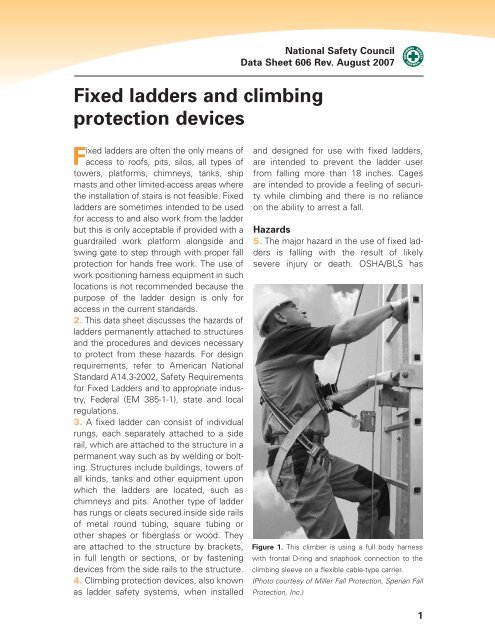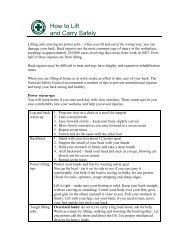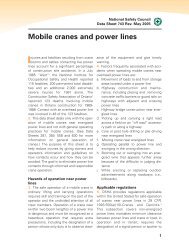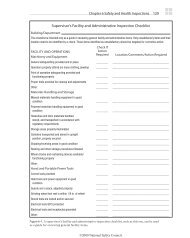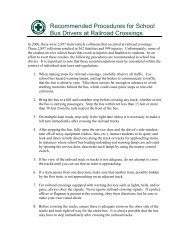Fixed ladders - National Safety Council
Fixed ladders - National Safety Council
Fixed ladders - National Safety Council
You also want an ePaper? Increase the reach of your titles
YUMPU automatically turns print PDFs into web optimized ePapers that Google loves.
<strong>National</strong> <strong>Safety</strong> <strong>Council</strong><br />
Data Sheet 606 Rev. August 2007<br />
<strong>Fixed</strong> <strong>ladders</strong> and climbing<br />
protection devices<br />
<strong>Fixed</strong> <strong>ladders</strong> are often the only means of<br />
access to roofs, pits, silos, all types of<br />
towers, platforms, chimneys, tanks, ship<br />
masts and other limited-access areas where<br />
the installation of stairs is not feasible. <strong>Fixed</strong><br />
<strong>ladders</strong> are sometimes intended to be used<br />
for access to and also work from the ladder<br />
but this is only acceptable if provided with a<br />
guardrailed work platform alongside and<br />
swing gate to step through with proper fall<br />
protection for hands free work. The use of<br />
work positioning harness equipment in such<br />
locations is not recommended because the<br />
purpose of the ladder design is only for<br />
access in the current standards.<br />
2. This data sheet discusses the hazards of<br />
<strong>ladders</strong> permanently attached to structures<br />
and the procedures and devices necessary<br />
to protect from these hazards. For design<br />
requirements, refer to American <strong>National</strong><br />
Standard A14.3-2002, <strong>Safety</strong> Requirements<br />
for <strong>Fixed</strong> Ladders and to appropriate industry,<br />
Federal (EM 385-1-1), state and local<br />
regulations.<br />
3. A fixed ladder can consist of individual<br />
rungs, each separately attached to a side<br />
rail, which are attached to the structure in a<br />
permanent way such as by welding or bolting.<br />
Structures include buildings, towers of<br />
all kinds, tanks and other equipment upon<br />
which the <strong>ladders</strong> are located, such as<br />
chimneys and pits. Another type of ladder<br />
has rungs or cleats secured inside side rails<br />
of metal round tubing, square tubing or<br />
other shapes or fiberglass or wood. They<br />
are attached to the structure by brackets,<br />
in full length or sections, or by fastening<br />
devices from the side rails to the structure.<br />
4. Climbing protection devices, also known<br />
as ladder safety systems, when installed<br />
and designed for use with fixed <strong>ladders</strong>,<br />
are intended to prevent the ladder user<br />
from falling more than 18 inches. Cages<br />
are intended to provide a feeling of security<br />
while climbing and there is no reliance<br />
on the ability to arrest a fall.<br />
Hazards<br />
5. The major hazard in the use of fixed <strong>ladders</strong><br />
is falling with the result of likely<br />
severe injury or death. OSHA/BLS has<br />
Figure 1. This climber is using a full body harness<br />
with frontal D-ring and snaphook connection to the<br />
climbing sleeve on a flexible cable-type carrier.<br />
(Photo courtesy of Miller Fall Protection, Sperian Fall<br />
Protection, Inc.)<br />
1
<strong>National</strong> <strong>Safety</strong> <strong>Council</strong><br />
Data Sheet 606 Rev. August 2007<br />
behind rungs. Training-related hazards are:<br />
Carrying objects such as papers, tools and<br />
equipment; holding side rails; leaning too<br />
far to the side of the ladder and failure to<br />
use three-point contact which optimizes<br />
lower risk factors.<br />
6. Other hazards include:<br />
a. Scratch and puncture wounds from<br />
burrs on the ladder, corrosion, poor<br />
splices or foreign materials that are not a<br />
part of the ladder<br />
b. Incorrect climbing procedures, such as<br />
sliding the rails or failure to use installed<br />
fall protection systems<br />
7. The fall hazard can be offset by installation<br />
and proper use of available climbing<br />
protection devices (Figure 1).<br />
8. Other hazards can be minimized by<br />
properly documented maintenance, proper<br />
training of personnel and by review of proper<br />
design prior to installation of fixed <strong>ladders</strong><br />
(Figure 2).<br />
Figure 2. Three-point contact must always be used<br />
when climbing <strong>ladders</strong>, using two hands and one foot<br />
or two feet and one hand to maintain prudent contact<br />
with the ladder at all times. (Illustration courtesy of<br />
Construction <strong>Safety</strong> Association of Ontario.) Note:<br />
Ten feet is the trigger height for fall protection on supported<br />
scaffolds.<br />
recorded 26 fall deaths from fixed <strong>ladders</strong><br />
during an 11-year period. Fall hazards are<br />
either design or training related. Designrelated<br />
hazards are: Non-uniform spacing<br />
of rungs attached by methods other than<br />
drilling each side rail and welding the rung<br />
on each side; rungs other than round; failure<br />
to provide horizontal grab bars for<br />
extension side rails (including roof hatches)<br />
and failure to provide 7 inches of toe space<br />
Selection of personnel<br />
9. Some individuals experience a feeling of<br />
instability or panic when climbing <strong>ladders</strong><br />
and can become disoriented. Others<br />
become frightened and suddenly aware of<br />
the fall hazard and freeze on the ladder. In<br />
such instances, the climber must be talked<br />
down, assisted and sometimes forcibly<br />
removed from the ladder. Persons with<br />
such tendencies should be disqualified as<br />
potential fixed ladder users unless their<br />
fears can be overcome by training. The<br />
higher the ladder, the higher the risk.<br />
10. Potential ladder users must be physically<br />
capable of the exertion required. They<br />
should be medically certified to be free<br />
from a history of heart disease, vertigo,<br />
seizures, fainting spells or other physical<br />
impairments that might make climbing particularly<br />
dangerous.<br />
• Climb deliberately and without haste.<br />
2
<strong>National</strong> <strong>Safety</strong> <strong>Council</strong><br />
Data Sheet 606 Rev. August 2007<br />
• Never run up or down a ladder and never<br />
slide down a ladder.<br />
• Never jump from a ladder.<br />
• Check footing before alighting from a<br />
ladder.<br />
• Wear shoes with heels and keep<br />
footwear clean.<br />
• See Training section to meet 1926.1060.<br />
Design and installation<br />
11. The design of fixed ladder systems<br />
must be under the supervision of a qualified,<br />
registered structural engineer or architect<br />
skilled in safe design of fixed <strong>ladders</strong>.<br />
12. Anyone responsible for the design,<br />
construction and installation of fixed <strong>ladders</strong><br />
must be familiar with the provisions of the<br />
American <strong>National</strong> Standard A14.3-2002,<br />
<strong>Safety</strong>, Requirements for <strong>Fixed</strong> Ladders: In<br />
addition, review the applicable regulations<br />
promulgated in the United States under the<br />
Occupational <strong>Safety</strong> and Health Act, as well<br />
as Federal Administration, (EM385-1-1<br />
(11/03) Corps of Engineers App. J), state or<br />
provincial and local regulations.<br />
13. The minimum open width for a rung<br />
length, 16 inches, is required in Standard<br />
A14.3-2002 and is of particular importance<br />
for <strong>ladders</strong> equipped with acceptable<br />
climbing protection devices to allow foot<br />
space. Rungs must be 3 ⁄4 inch or 1 inch in<br />
diameter depending on likelihood for corrosion.<br />
Side rails should be 1 ⁄2 inch by 2 1 ⁄2 inches<br />
so extension side rails need not be<br />
supported for stability. Horizontal grab bars<br />
are necessary for momentary grabbing the<br />
rung or equivalent if the foot slips. Side<br />
rails should be bar stock but never angle<br />
iron or channel that cannot be gripped<br />
effectively under fall conditions.<br />
14. A fixed ladder must never be installed in<br />
a manner detrimental to personnel who may<br />
be on the underside of a ladder when climbing.<br />
Reverse climbing slopes are prohibited.<br />
15. <strong>Fixed</strong> <strong>ladders</strong> (at least the extension<br />
Figure 3. A typical elevated platform ladder has a<br />
guardrail and a fall protection system such as a selfretracting<br />
lanyard mounted above the platform.<br />
(Courtesy Sellstrom/RTC.)<br />
side rails) must extend a minimum of 42<br />
inches above the landings they serve. They<br />
should be equipped with horizontal grab<br />
bars in case the feet slip from the rungs so<br />
the hands can be used effectively.<br />
According to U.S. Army EM 385-1-1 4(d):<br />
“Horizontal grab bars shall be provided to<br />
facilitate grip. Grab bar diameters shall be<br />
spaced by a continuation of the rung spacing.<br />
Grab bar diameters shall be the equivalent<br />
of round rung diameters.”<br />
16. All roof access <strong>ladders</strong> with point of<br />
access at an elevated location should have<br />
a cage and/or ladder safety devices to deter<br />
or protect against falls (Figures 3 and 4).<br />
Ladders with a length of climb of more<br />
than 24 feet must have a cage or climbing<br />
protection (Figure 4). The cage must start 7<br />
to 8 feet above the ground or the platform<br />
3
<strong>National</strong> <strong>Safety</strong> <strong>Council</strong><br />
Data Sheet 606 Rev. August 2007<br />
Figure 4. This fixed ladder has a cage. Note: There<br />
must be a platform for every 50 feet of ladder, as<br />
given in ANSI A14.3-2002 “shall be of a type which<br />
can be operated entirely hands-free by the person<br />
using the ladder safety system. It shall permit the<br />
person using the ladder safety system to ascend or<br />
descend without having to continually manipulate the<br />
safety sleeve.”<br />
Note: Some climbing protection devices may stick<br />
due to lack of oils particularly low temperature silicones<br />
in cold icy weather or from ambient dust and<br />
dirt around sliding or rotating parts.<br />
(Courtesy Sellstrom/RTC.)<br />
landing where the ladder begins. CFR<br />
1910.27(d)(ii) regulations are similar cages<br />
or ladder safety systems at 20 feet.<br />
17. Provide adequate illumination to safeguard<br />
personnel where necessary. A minimum<br />
lighting intensity of five foot-candles<br />
is suggested per IES Chapter 29, 9 th edition.<br />
Install lamps so they do not glare. All<br />
lighting fixtures must be guarded from vandalism,<br />
electrically insulated and grounded.<br />
18. Where environmental conditions are<br />
oily, icy or wet, completely enclose fixed<br />
<strong>ladders</strong> if possible. Note: Some manufacturers<br />
of climbing protection rail systems provide<br />
a heating wire to melt ice on the rail<br />
19. If fixed <strong>ladders</strong> are on structure exteriors<br />
accessible to the public, the bottom 7<br />
to 8 feet must be excluded from public<br />
access. A fence with locked gates may be<br />
feasible, or the unguarded portion made<br />
removable and used only as needed such<br />
as many transmission or telecommunication<br />
towers.<br />
20. At the base of each fixed ladder, there<br />
must be a warning sign to prohibit use by<br />
unauthorized personnel.<br />
21. Warning! <strong>Fixed</strong> <strong>ladders</strong> must not be<br />
installed within reach of existing electrical<br />
conductors nor should new electrical conductors<br />
be installed near a fixed ladder.<br />
Long tools or jets of water may cause<br />
grounding and warnings may be needed if<br />
the hazards are analyzed carefully and cannot<br />
be eliminated.<br />
22. Item 7.3.1 of the <strong>Safety</strong> Requirements<br />
for <strong>Fixed</strong> Ladders reads as follows: “The<br />
safety sleeve shall be above the top for<br />
proper dismount and subsequent access.<br />
23. Acceptable types of climbing protection<br />
systems are as follows:<br />
a. A rail or wire cable fixed to the ladder, on<br />
which a sleeve travels. Rails provide<br />
more stability and are less easily damaged<br />
by wind vibration. Cable stays are<br />
required every 40 feet apart to avoid<br />
wind vibration contact damage. Workers<br />
may fail to reinstall them properly leading<br />
to broken cable wires that could<br />
affect the smooth operation of the climbing<br />
protection device.<br />
b. A sleeve fastened to the climber’s full<br />
body harness by snaphook and/or a<br />
4
<strong>National</strong> <strong>Safety</strong> <strong>Council</strong><br />
Data Sheet 606 Rev. August 2007<br />
short connector; the total length of<br />
which should be 9 inches. Note: For harness<br />
connection at the chest, a 12-inch<br />
connection may be required for proper<br />
climbing if the manufacturer has tested<br />
for a 24-inch free fall. Make sure the connection<br />
does not twist the device so it<br />
locks too quickly.<br />
c. A roof hatch that opens onto a flat commercial<br />
roof needs to be strong enough<br />
for a security barrier and rigid enough to<br />
act as an anchorage point for fall arrest<br />
devices. Exterior extension side rails<br />
equipped with horizontal grab bars are<br />
required in the U.S. Army <strong>Safety</strong> Manual<br />
EM385-1-1 (11/03) standard for proper<br />
access and especially descent from the<br />
roof. Appendix J 3h: “Openings shall be<br />
provided with elevated horizontal grab<br />
bars to facilitate access and exit from<br />
upper levels”<br />
24. The need for a flared upper extension<br />
side rail section depends on whether the<br />
climber has tools around his/her waistline<br />
on a tool belt. It is normally sufficient to<br />
have an 18-inch opening for persons to<br />
step through and little need for the 24 to<br />
36-inch openings once required when<br />
cranes or hoists were not available for lifting<br />
tool boxes and equipment onto platforms<br />
overhead.<br />
25. Install these devices according to the<br />
manufacturer’s instructions. Note: Climbing<br />
protection systems are intended for maintenance<br />
work and possibly operations in<br />
some applications where practical. These<br />
systems are only applicable for emergency<br />
escape when sufficient harnesses and<br />
climbing protection devices with connecting<br />
means exist in a secured and protected<br />
enclosure for a stated capacity. Remote<br />
climbing locations, such as telecommunications<br />
towers should have secured and protective<br />
containers at the base of each<br />
ladder with user documentation.<br />
26. At a steady climbing speed, the sleeve<br />
slides up and down without hindrance. If<br />
the climber falls, however, a locking cam or<br />
friction brake is activated to automatically<br />
stop the fall. Climbing down too quickly<br />
often causes the sensitive climbing protection<br />
device to lock causing unnecessary<br />
aggravation with the system.<br />
27. The top side of the rail or cable (bracket)<br />
must extend 3 feet above the top landing<br />
for proper dismount and subsequent<br />
access.<br />
28. Sufficiently close distances are<br />
required to allow the climber to alight from<br />
the ladder and position behind a protective<br />
gate or barrier before disengaging from the<br />
climbing protection device, or to reattach<br />
the climbing protection device before stepping<br />
onto the ladder. A ladder safety gate is<br />
required to provide protection on the platform<br />
and to allow detachment or reattachment<br />
to the safety device before the<br />
exposure of the opening is permitted.<br />
Users must hold different rungs in each<br />
hand as they climb in case corrosion has<br />
occurred.<br />
29. Item 4.1.4.2 of ANSI A14.3-2002, <strong>Safety</strong><br />
Requirements for <strong>Fixed</strong> Ladders, reads as<br />
follows: “Ladder safety systems shall be<br />
used when the length of climb of a ladder or<br />
section <strong>ladders</strong> exceeds 50 feet in a single<br />
length of climb and rest platforms shall be<br />
provided at maximum intervals of 150 feet.”<br />
Note: OSHA 1910.27(d)(2) states 20 feet<br />
without a cage and 30 feet with a cage, rest<br />
or landing platforms must be provided.<br />
Inspection and maintenance<br />
30. Before general use is permitted, an<br />
inspection must be made and documented<br />
of every new fixed ladder installation to<br />
determine that it has been installed in<br />
accordance with the provisions of the<br />
American <strong>National</strong> Standards Institute and<br />
the applicable federal, state or provincial,<br />
5
<strong>National</strong> <strong>Safety</strong> <strong>Council</strong><br />
Data Sheet 606 Rev. August 2007<br />
and local regulations and the instructions<br />
climbing protection system manufacturer.<br />
A checklist containing the requirements in<br />
this data sheet is recommended. Inspect<br />
all <strong>ladders</strong> regularly, such as every six<br />
months determining the intervals between<br />
inspection by use and exposure but no<br />
period greater than 12 months.<br />
31. A warning and sign shall be posted<br />
that a proper harness with a frontal D-ring<br />
and 9-inch connection shall only be used,<br />
and that full-body harnesses and 6-foot,<br />
shock-absorbing lanyards or their equivalent<br />
are prohibited for use with the climbing<br />
protection system. Periodic inspection<br />
of all fixed <strong>ladders</strong>, cages and climbing protection<br />
devices, and the prompt correction<br />
of any defects are imperative to their continued<br />
use.<br />
32. Some hazards to look for during periodic<br />
inspections are:<br />
• Loose, worn and damaged or corroded<br />
rungs or side rails<br />
• Damaged or corroded parts of the cage<br />
• Corroded or loose bolts and rivet heads,<br />
especially on the inside of metal stacks<br />
• Damaged or corroded handrails and<br />
brackets on platforms<br />
• Deteriorated masonry where fixed ladder<br />
anchorages are secured to a structure<br />
• Defects in climbing device tolerances,<br />
including damaged snaphooks, loose or<br />
damaged carrier rails or cables<br />
• Unauthorized parts in the system, such as<br />
incompatible snaphooks or connectors<br />
• Smooth rungs in the center portion must<br />
be made slip-resistant<br />
• Lack of horizontal grab bars in the area of<br />
extension side rails<br />
• Objects and pipes within 27 inches of<br />
the climbing face of the ladder that may<br />
interfere with climbing<br />
• Sufficient foot space either side of the<br />
carrier for safe climbing<br />
• No obstruction behind the ladder for<br />
seven inches at any location during the<br />
climb<br />
33. Training: To meet 1926.1060:<br />
• Proper climbing: use of flexible gloves<br />
with adequate friction<br />
• Boots with steel or synthetic spine or<br />
shank and a well-defined heel<br />
• Grasp rungs with full-hand rounded grip<br />
only, never side rails, to avoid catastrophic<br />
fall consequences.<br />
• Do not climb <strong>ladders</strong> with sharp edge<br />
rungs that could cut or injure the hands<br />
grip capacity in a fall or during repeat<br />
climbing usage.<br />
• Climb with face toward ladder only.<br />
• Step on rungs between the ball of the<br />
sole and the heel.<br />
• Only hold one particular rung with a<br />
hand; grasp another rung with the other<br />
hand<br />
• Do not sit on a ladder platform guardrail<br />
or stand up on a midrail.<br />
• Practice three-point climbing with close<br />
observation of a supervisor or trainer.<br />
(Note: this is a counterintuitive technique<br />
and must be regularly practiced<br />
with supervision)<br />
34. Rescue: Tested climbing protection<br />
systems are certified to have survived a 500<br />
pounds free-fall through 18 inches or the<br />
distance of free fall dictated by twice the<br />
connecting distance between the harness<br />
and the climbing protection device. The reason<br />
that 500 pounds was chosen for the<br />
test in the 1940s was based on rescue by a<br />
government climber who would piggyback<br />
under a stricken climber, lifting his connecting<br />
device to permit both climbers to<br />
descend. Thus two climbers at 250 pounds<br />
each would equal 500 pounds between<br />
attachments of the ladder to the structure.<br />
That concept has been abandoned in the<br />
past 20 years (but not the test) due to diffi-<br />
6
<strong>National</strong> <strong>Safety</strong> <strong>Council</strong><br />
Data Sheet 606 Rev. August 2007<br />
culty by trained climber rescuers. Thus pulleys<br />
and rope rescue and self-retracting lanyards<br />
have become more popular as tools<br />
for prompt rescue with suitable front or<br />
back D-ring suspension points. Where<br />
heights are several hundred feet, it is not<br />
enough to designate the local fire departments<br />
that are often under-equipped and<br />
lack speedy provision of manpower. Hence<br />
rope access systems used by trained technicians<br />
in a crew are becoming the option<br />
of choice throughout the world for climbing<br />
and emergency descent.<br />
35. Scaffold <strong>ladders</strong>: portable, hook-on,<br />
attachable or integral frame access is permitted<br />
by OSHA 1926.451(e) with reference<br />
to Subpart X for portable <strong>ladders</strong>.<br />
However, integral frame <strong>ladders</strong> must have<br />
horizontal members less than 16 3 ⁄4 inches<br />
apart and be uniformly spaced except<br />
between frames, at least 8 inches in<br />
length. No access using cross-braces is<br />
permitted. Fall protection is required over<br />
10 feet for access and a competent person<br />
must determine feasibility for erection,<br />
moving or dismantling. Self-retracting lanyards<br />
installed above shoulder height are<br />
recommended for tube and coupler<br />
attached <strong>ladders</strong> and integral frame <strong>ladders</strong><br />
36. Non-compliant Ladders: some structures<br />
like grain silos offer door handles for<br />
climbing and an aluminum or concrete<br />
enclosure for grain pouring that can act as<br />
a cage. Others are 12-inches rung width for<br />
ladder access to railroad signals. Some<br />
water tower manufacturers and merchant<br />
marine shipbuilders provide diamond<br />
shape rungs on fixed <strong>ladders</strong>. Helicopter<br />
maintenance access to the rotor blades<br />
have recessed steps and grab bars.<br />
Scaffold ladder frames may not be classified<br />
as a fixed ladder; likewise trailers and<br />
tankers for road and rail. Rebar mattes are<br />
similar to fixed <strong>ladders</strong>. Curved water tank<br />
bowl <strong>ladders</strong> and astronomy dishes with<br />
flat angles less than 70 degrees pose posture<br />
and connection length problems for<br />
climbers. For all these types of climbing<br />
structures the answer may be back-up fall<br />
protection both before and after the <strong>ladders</strong><br />
are standardized in respective industry<br />
standards. Step bolts are occasionally an<br />
alternative to <strong>ladders</strong> with offset or parallel<br />
steps consisting of bolts with heads to limit<br />
side slipping but pose a severe injury hazard<br />
if a faller catches a bolt under a body<br />
part, and are known to fail on transmission<br />
towers from time to time while climbing<br />
and should be proof-tested periodically.<br />
Sources of information<br />
American <strong>National</strong> Standards Institute, 25 West 43 rd<br />
Street, 4 th floor, New York, NY 10036.<br />
<strong>Safety</strong> Requirements for <strong>Fixed</strong> Ladders, A14.3-2002.<br />
U.S. Army <strong>Safety</strong> and Health Requirements Manual<br />
EM 385-1-1 (11/03).<br />
HSE Report on caged <strong>ladders</strong>: Preliminary investigation<br />
into the fall-arresting effectiveness of ladder safety<br />
hoops. HSE Research Report 258 (<strong>Safety</strong> Squared<br />
2004), http://www.hse.gov.uk/research/rrpdf/rr258.pdf.<br />
Acknowledgment<br />
This data sheet was revised by the<br />
Construction Division membership, of the<br />
<strong>National</strong> <strong>Safety</strong> <strong>Council</strong>, 1121 Spring Lake<br />
Drive, Itasca, IL 60143.<br />
Copyright 2008 <strong>National</strong> <strong>Safety</strong> <strong>Council</strong>.<br />
All rights reserved.<br />
Although the information and recommendations contained<br />
in this publication have been compiled from<br />
sources believed to be reliable, the <strong>National</strong> <strong>Safety</strong><br />
<strong>Council</strong> makes no guarantee as to, and assumes no<br />
responsibility for, the correctness, sufficiency or<br />
completeness of such information or recommendations.<br />
Other or additional safety measures may be<br />
required under particular circumstances.<br />
7


